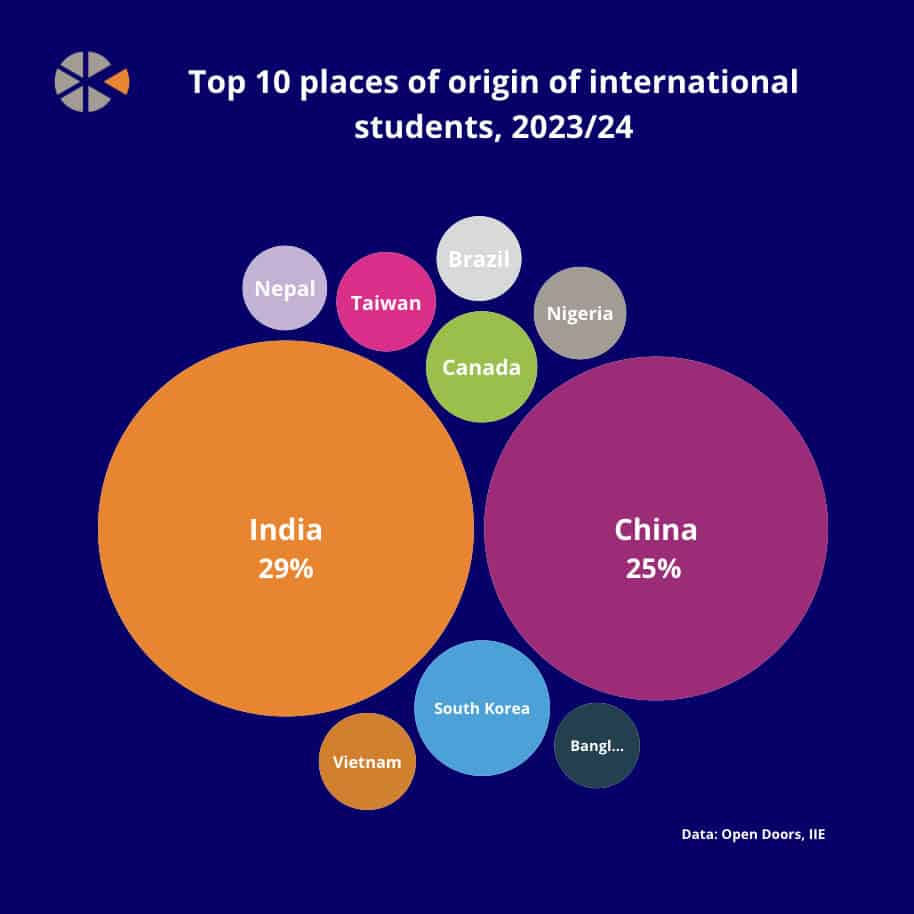The report, published on November 18, revealed a 7% increase in international student numbers on the previous year, with IIE forecasting continued growth over the next five years.
“With nearly 4,000 education institutions overall, the US has the most capacity to host more international students. International students make up just 6% of total US higher education enrolment,” said Mirka Martel, IIE’s head of research, evaluation and learning.
For the first year since 2009, India overtook China as the top sending country, seeing 331,602 Indian students pursuing higher education in the US, a 35% increase on the previous year.
International graduate students and students in Optical Practical Training (OPT) hit record highs, increasing by 8% and 22% respectively, while undergraduate levels decreased by 1%.
Despite a 4% decline in students, China was the second leading country of origin and remained the top-sending country for undergraduates and non-degree students.
While stakeholders have expressed concerns over Trump’s recent appointment of anti-immigration Stephen Miller as incoming deputy chief of staff, IIE is forecasting the continued growth of international student numbers, including those from China.
IIE’s Student Enrolment Snapshot for the start of the 2024/25 year indicated a continuation of the trend, reporting a 3% rise in international student enrolments across 680 US institutions, with a continued marked increase in OPT.
“The next four to five years are going to show a lot of growth in international students coming to the US”, said IIE CEO Allan Goodman.
“China makes up a very substantial portion of undergraduate and graduate students coming to the United States… They have been welcome here all through periods of hot and cold and good and bad relationships. So, I think the flow is going to continue and we welcome them.”
“Multiple factors” could have caused the decline in Chinese students, including the continued impact of Covid-19 related travel effects, demographic factors in China and the home country capacity of China’s undergraduate system, said Martel.
Together, India and China made up 54% total international enrolments, but notable growth was also seen in Sub-Saharan Africa where totals grew by 13% in 2023/24, the highest growth rate among all world regions for the second consecutive year.
Nigeria was the top sending country from Sub-Saharan Africa, ranking seventh overall, with Ghana seeing the largest percentage increase of 45% on the previous year.
Elsewhere, eight of the top 25 sending countries reached all-time highs, including Bangladesh, Colombia, Ghana, India, Italy, Nepal, Pakistan and Spain.
Amid tightening visa restrictions on international students in Canada and Australia, “students are voting with their feet”, said Goodman.
“They’re seeing where the caps and restrictions are and gravitating to places where there are no caps, and that puts the US in a very unique position.
“And not only that, but we have the capacity to have many more international students and we welcome them”, added Goodman.
The report noted the economic benefit of international students, who contributed $50 billion to the US economy in 2023 and lay the foundation for future relationships in business and trade, science and innovation and government relations.
Despite the all-time highs, international students only make up 6% of total students in the US, compared to 26% in the UK, a similar proportion in Australia and close to 40% in Canada.
The growth experienced in the US reflects a global trend of increasing student mobility.
“In 2022, according to UNESCO, there were 6.9 million students who were globally mobile – an increase of 8% from the prior year – so it’s really exciting to see that there are more students who are choosing to pursue education abroad,” said Martel.
Students are seeing where the caps and restrictions are and gravitating to places where there are no caps, and that puts the US in a very unique position
Allan Goodman, IIE
California, New York and Texas hosted the largest number of international students, with levels rising in 44 states.
Over half (56%) pursued STEM fields of study, notably maths and computer science, and engineering.
Following Donald Trump’s recent re-election to the White House, leading study abroad choice platforms in the US reported a surge in interest from US students exploring education opportunities overseas.
This builds on the 49% increase in US students pursuing educational opportunities abroad in 2022/23, with nearly half of students choosing Italy, the UK, Spain and France, according to the report.
Since the pandemic, students are increasingly choosing a broader range of study abroad destinations, with Denmark, Greece, Italy, Japan, Singapore, South Korea and Switzerland all reaching all-time highs in 2022/23.
The post US international student numbers reach all-time high appeared first on The PIE News.


